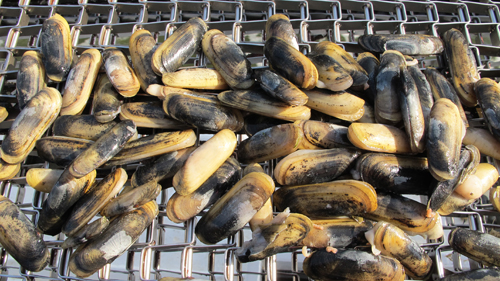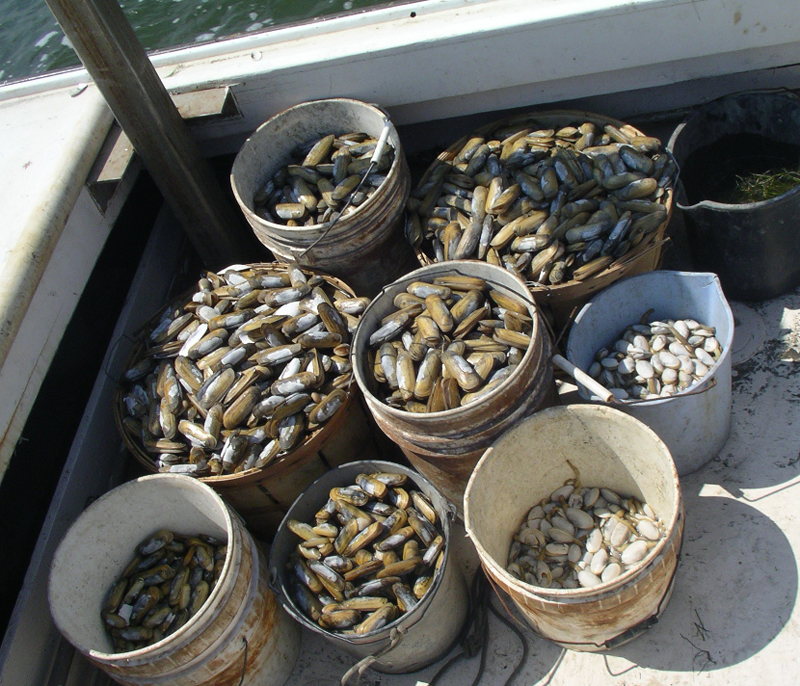Brief History of the Stout Razor Clam Fishery
in the Chesapeake Bay
 The history of the stout razor clam as a commercial species in the Chesapeake Bay is not well documented. Until very recently, landing data were not collected and the only information regarding commerce comes from those in the industry. It appears that razor clams became increasingly targeted in the early 1980's, perhaps due to a series of events that included declining softshell clam populations and markets and the need for inexpensive, efficient blue crab bait as American eel prices soared. After the softshell clam population crash in the early 1990's, most commercial clammers, from what can be gathered, focused on the stout razor clam.
The history of the stout razor clam as a commercial species in the Chesapeake Bay is not well documented. Until very recently, landing data were not collected and the only information regarding commerce comes from those in the industry. It appears that razor clams became increasingly targeted in the early 1980's, perhaps due to a series of events that included declining softshell clam populations and markets and the need for inexpensive, efficient blue crab bait as American eel prices soared. After the softshell clam population crash in the early 1990's, most commercial clammers, from what can be gathered, focused on the stout razor clam.
In late 2003, watermen contacted DNR and reported unprecedented numbers of dead razor clam coming up their escalators in several areas of the Bay. Subsequent surveys confirmed this and by late 2004 it was estimated that between 60 and 70% of the stout razor clam Chesapeake Bay population had died. High, periodic mortalities have been documented from 2004 through the present. Since 2004, harvest catch rates have reportedly plummeted, from 8-10 bushels per hour to 3-5 bph to currently 1-2 bph. These declines have been generally confirmed from field survey results.
In 2000, Perkinsus chesapeaki infections were discovered in T. plebeius populations and in 2001 the first case of DN (disseminated neoplasia) disease was found in stout razor clams. It is apparent that the widespread and catastrophic mortality first reported in late 2003 was caused by one or both of these diseases.
Since the high rates of mortality began in late 2003, razor clam populations have re-established in some areas, albeit at lower levels of abundance. Disease has not abated, though, and their population continues to exhibit high rates of non-fishing related mortality.
 The economic value of the stout razor clam in the Chesapeake Bay has not been documented. Harvest data have only recently started to be officially kept and are not reflective of landings prior to the massive Bay-wide mortalities first observed in late 2003. Accounts from those involved in the industry indicate that razor clams became a targeted commercial species in the early 1980s. It was during this period that American eel prices skyrocketed, virtually eliminating them as affordable bait in the blue crab industry. As softshell clam populations declined and their markets became less predictable, razor clam production gradually became the staple of the Bay's hydraulic escalator dredge-based fishery inextricably linked to the blue crab industry. Without landings information or ex-vessel sale prices, it's impossible to estimate the dollar value of the fishery. What can be stated, though, is the extreme importance of the stout razor clam in the contemporary blue crab industry.
The economic value of the stout razor clam in the Chesapeake Bay has not been documented. Harvest data have only recently started to be officially kept and are not reflective of landings prior to the massive Bay-wide mortalities first observed in late 2003. Accounts from those involved in the industry indicate that razor clams became a targeted commercial species in the early 1980s. It was during this period that American eel prices skyrocketed, virtually eliminating them as affordable bait in the blue crab industry. As softshell clam populations declined and their markets became less predictable, razor clam production gradually became the staple of the Bay's hydraulic escalator dredge-based fishery inextricably linked to the blue crab industry. Without landings information or ex-vessel sale prices, it's impossible to estimate the dollar value of the fishery. What can be stated, though, is the extreme importance of the stout razor clam in the contemporary blue crab industry.
Razor Clam Life History